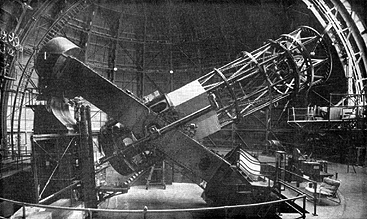 Пояснение: В 1920-х годах фотографии, полученные на телескопе им. Дж.Д.Хуккера в обсерватории Маунт Вилсон, основательно изменили представления людей о Космосе. Астроном Эдвин Хаббл с помощью этих фотографий, показал, что называемые его современниками "спиральные туманности" на самом деле являлись огроменными звездными системами - спиральными галактиками, похожими на наш Млечный Путь, - но удаленными на большое расстояние. До работ Хаббла считалось, что "спиральные туманности" - это просто газовые облака, которые наравне с многими другими объектами Вселенной находятся в Нашей Галактике. Зеркало телескопа им. Дж.Д.Хуккера составляет 100 дюймов (2.5 м) (примерно такой же размер имеет зеркало космического телескопа, названного в честь Э. Хаббла). Обсерватория Маунт Вилсон предлагает Вам совершить "виртуальный тур", посвященный этому историчекому телескопу.
Пояснение: В 1920-х годах фотографии, полученные на телескопе им. Дж.Д.Хуккера в обсерватории Маунт Вилсон, основательно изменили представления людей о Космосе. Астроном Эдвин Хаббл с помощью этих фотографий, показал, что называемые его современниками "спиральные туманности" на самом деле являлись огроменными звездными системами - спиральными галактиками, похожими на наш Млечный Путь, - но удаленными на большое расстояние. До работ Хаббла считалось, что "спиральные туманности" - это просто газовые облака, которые наравне с многими другими объектами Вселенной находятся в Нашей Галактике. Зеркало телескопа им. Дж.Д.Хуккера составляет 100 дюймов (2.5 м) (примерно такой же размер имеет зеркало космического телескопа, названного в честь Э. Хаббла). Обсерватория Маунт Вилсон предлагает Вам совершить "виртуальный тур", посвященный этому историчекому телескопу.Тайлбар: 1920-оод оны үед Вилсон уулан дээрх Хукерийн нэрэмжит телескопоос авсан зургууд бидний сансрын тухай ойлголтыг үндсээр нь өөрчилсөн юм. Одон оронч Эдвин Хаббл энэ телескопоор авсан зургуудыг ашиглан тэр үеийнхний мушгиа мананцар гэж үзэж байсан зүйл нь манай Сүүн зам шиг олон мушгиа одны ордыг агуулсан асар хол зайд орших оддын систем болохыг үзүүлсэн. Хабблын нээлтээс өмнө мушгиа мананцарууд нь ердөө л хийн үүл ба орчлонгийн бүх юмсын адил манай галактикт багтдаг гэж үздэг байлаа. Хукерийн нэрэмжит телескопын толь нь 2.5 м юм (Хабблын нэрээр нэрлэгдсэн сансрын дуран бас ийм хэмжээний тольтой). Вилсон уулын сансар судлалын төв энэ түүхэн телескопт зориулсан “виртуал аяллыг” зохион байгуулдаг.
Explanation: In the 1920s, pictures from the Hooker Telescope on Mt. Wilson fundamentally changed our understanding of the cosmos. Astronomer Edwin Hubble, using photographs he took with this telescope, demonstrated that the objects his contemporaries called "spiral nebulae" were actually huge systems of stars - spiral galaxies, similar to our own Milky Way galaxy but incredibly distant. Prior to Hubble's work it was argued that the spiral nebulae were mere clouds of gas and that they, along with everything else in the universe, were contained in our own galaxy. The Hooker Telescope mirror is 100 inches in diameter which is nearly the size of the mirror of the orbiting Hubble Space Telescope named in Hubble's honor. The Mount Wilson Observatory offers a "virtual walking tour" of this historic telescope.
Keine Kommentare:
Kommentar veröffentlichen